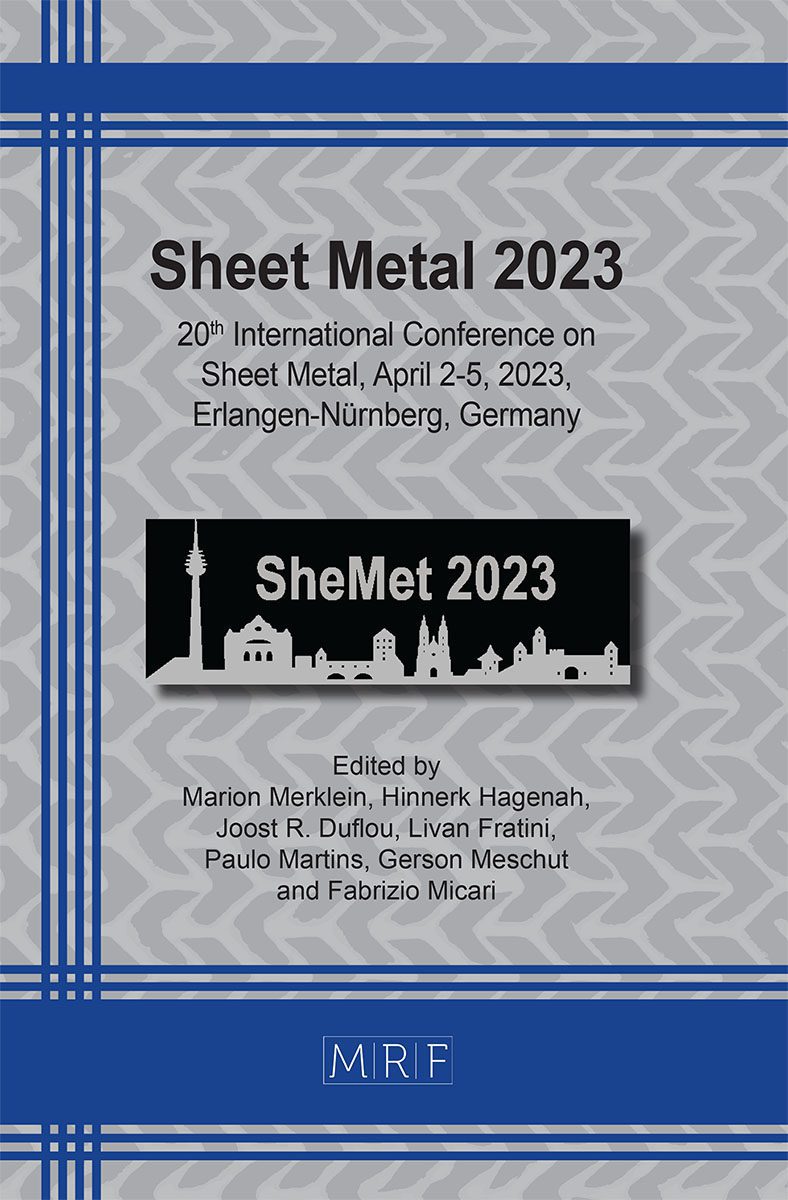Numerical investigation on the influence of hydroxide production on the high-cycle fatigue behavior of clinched joints
Sven Harzheim, Martin Hofmann, Thomas Wallmersperger
download PDFAbstract. Corrosion usually has detrimental effects on the longevity of metallic structures. Several corrosion mechanisms exist, which affect the metallic structures differently. Galvanic corrosion is a major corrosion phenomenon that occurs when two dissimilar metals are in contact with each other and with an electrolyte. Due to galvanic corrosion, the less noble metal dissolves which can shorten the service life of the metallic component significantly. However, recent research has shown that corrosion can have a beneficial impact on metal joints. Brief exposure of clinched specimens to a salt spray environment extends the corroded specimen’s fatigue life. The present work introduces a simulation procedure which can numerically predict the effects of corrosion product formation on the fatigue life of clinched joints.
Keywords
Finite Element Method (FEM), Fatigue, Galvanic Corrosion
Published online 3/17/2023, 8 pages
Copyright © 2023 by the author(s)
Published under license by Materials Research Forum LLC., Millersville PA, USA
Citation: Sven Harzheim, Martin Hofmann, Thomas Wallmersperger, Numerical investigation on the influence of hydroxide production on the high-cycle fatigue behavior of clinched joints, Materials Research Proceedings, Vol. 25, pp 255-262, 2023
DOI: https://doi.org/10.21741/9781644902417-32
The article was published as article 32 of the book Sheet Metal 2023
![]() Content from this work may be used under the terms of the Creative Commons Attribution 3.0 licence. Any further distribution of this work must maintain attribution to the author(s) and the title of the work, journal citation and DOI.
Content from this work may be used under the terms of the Creative Commons Attribution 3.0 licence. Any further distribution of this work must maintain attribution to the author(s) and the title of the work, journal citation and DOI.
References
[1] X. He, Clinching for sheet materials, Science and Technology of Advanced Materials. 18:1 (2017) 381-405. https://doi.org/10.1080/14686996.2017.1320930
[2] B. Schramm, S. Harzheim, D. Weiß, T. D. Joy, M. Hofmann, G. Meschut, J. Mergheim, T. Wallmersperger, A Review on the Modeling of the Clinching Process Chain – Part III: Operational Phase, Journal of Advanced Joining Processes. 6 (2022) 100135. https://doi.org/10.1016/j.jajp.2022.100135
[3] S. Harzheim, L. Ewenz, M. Zimmermann, T. Wallmersperger, Corrosion Phenomena and Fatigue Behavior of Clinched Joints, Numerical and Experimental Investigations. 6 (2022) 100130. https://doi.org/10.1016/j.jajp.2022.100130
[4] L. Calabrese, E. Proverbio, G. Galtieri, C. Borsellino, Effect of corrosion degradation on failure mechanisms of aluminium/steel clinched joints, Materials & Design. 87 (2015) 473-481. https://doi.org/10.1016/j.matdes.2015.08.053
[5] W. Mai, S. Soghrati, New phase field model for simulating galvanic and pitting corrosion processes, Electrochimica Acta. 260 (2018) 290-304. https://doi.org/10.1016/j.electacta.2017.12.086
[6] W. Mai, S. Soghrati, A phase field model for simulating the stress corrosion cracking initiated from pits, Corrosion Science. 125 (2017) 87-98. https://doi.org/10.1016/j.corsci.2017.06.006
[7] R. Dekker, F. P. van der Meer, J. Maljaars, L. J. Sluys, A level set model for stress‐dependent corrosion pit propagation, International Journal for Numerical Methods in Engineering. 122(8) (2021) 2057-2074. https://doi.org/10.1002/nme.6614
[8] S. Sarkar, J. E. Warner, W. Aquino, A numerical framework for the modeling of corrosive dissolution, Corrosion science. 65 (2012) 502-511. https://doi.org/10.1016/j.corsci.2012.08.059
[9] J. Lemaitre, J. Sermage, R. Desmorat, A two scale damage concept applied to fatigue, International Journal of Fracture. 97 (1999) 67-81. https://doi.org/10.1023/A:1018641414428
[10] H. Argente dos Santos, F. Auricchio, M. Conti, Fatigue life assessment of cardiovascular balloon-expandable stents: a two-scale plasticity-damage model approach, Journal of The Mechanical Behavior of Biomedical Materials. 15 (2012) 78-92. https://doi.org/10.1016/j.jmbbm.2012.06.011
[11] R. Desmorat, A. Kane, M. Seyedi, J. P. Sermage, Two scale damage model and related numerical issues for thermo-mechanical High Cycle Fatigue, European Journal of Mechanics – A/Solids. 26 (2007) 909–935. https://doi.org/10.1016/j.euromechsol.2007.01.002































